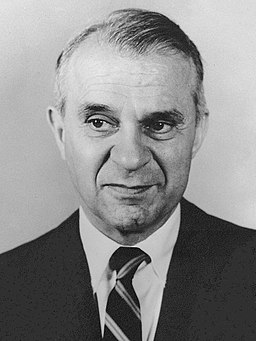
Wassily Leontief
1906-1999

From the time he was a young man growing up in Saint Petersburg, Wassily Leontief devoted his studies to input-output analysis. When he left Russia at the age of nineteen to begin the Ph.D. program at the University of Berlin, he had already shown how leon walras’s abstract equilibrium theory could be quantified. But it was not until many years later, in 1941, while a professor at Harvard, that Leontief calculated an input-output table for the American economy. It was this work, and later refinements of it, that earned Leontief the Nobel Prize in 1973.
Input-output analysis shows the extensive process by which inputs in one industry produce outputs for consumption or for input into another industry. The matrix devised by Leontief is often used to show the effect of a change in production of a final good on the demand for inputs. Take, for example, a 10 percent increase in the production of shoes. With the input-output table, one can estimate how much additional leather, labor, machinery, and other inputs will be required to increase shoe production.
Most economists are cautious in using the table because it assumes, to use the shoe example, that shoe production requires the inputs in the proportion they were used during the time period used to estimate the table. There’s the rub. Although the table is useful as a rough approximation of the inputs required, economists know from mountains of evidence that proportions are not fixed. Specifically, when the cost of one input rises, producers reduce their use of this input and substitute other inputs whose prices have not risen. If wage rates rise, for example, producers can substitute capital for labor and, by accepting more wasted materials, can even substitute raw materials for labor. That the input-output table is inflexible means that, if used literally to make predictions, it will necessarily give wrong answers.
At the time of Leontief’s first work with input-output analysis, all the required matrix algebra was done using hand-held calculators and sheer tenacity. Since then, computers have greatly simplified the process, and input-output analysis, now called “interindustry analysis,” is widely used. Leontief’s tables are commonly used by the World Bank, the United Nations, and the U.S. Department of Commerce.
Early on, input-output analysis was used to estimate the economy-wide impact of converting from war production to civilian production after World War II. It has also been used to understand the flow of trade between countries. Indeed, a 1954 article by Leontief shows, using input-output analysis, that U.S. exports were relatively labor intensive compared with U.S. imports. This was the opposite of what economists expected at the time, given the high level of U.S. wages and the relatively high amount of capital per worker in the United States. Leontief’s finding was termed the Leontief paradox. Since then, the paradox has been resolved. Economists have shown that in a country that produces more than two goods, the abundance of capital relative to labor does not imply that the capital intensity of its exports should exceed that of its imports.
Throughout his life Leontief campaigned against “theoretical assumptions and nonobserved facts” (the title of a speech he delivered while president of the American Economic Association, 1970–1971). According to Leontief too many economists were reluctant to “get their hands dirty” by working with raw empirical facts. To that end Wassily Leontief did much to make quantitative data more accessible, and more indispensable, to the study of economics.
About the Author
David R. Henderson is the editor of The Concise Encyclopedia of Economics. He is also an emeritus professor of economics with the Naval Postgraduate School and a research fellow with the Hoover Institution at Stanford University. He earned his Ph.D. in economics at UCLA.
Selected Works
Related Entries
Related Links
